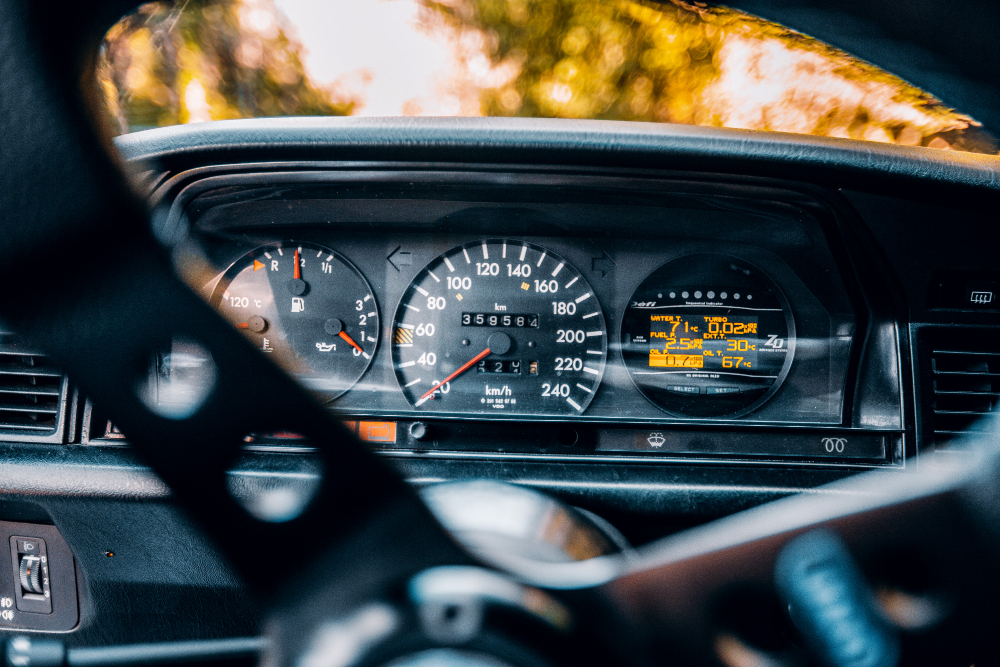Fleet managers and business owners in logistics and transportation companies face a myriad of challenges when it comes to optimizing their operations.
These challenges include inaccurate assessments, unexpected maintenance costs, decreased vehicle lifespans, operational inefficiencies, limited data, and environmental concerns. The solution to many of these problems lies in a seemingly unassuming metric: engine hours.
This comprehensive guide will explore the world of engine hours and how they can revolutionize how you manage your fleet.
We’ll delve into what engine hours are, digital methods to track them, how to measure and calculate them, and why you should be tracking them.
Turn Idle Hours into Efficient Outcomes
Turn engine hours into proactive fleet management, reduce costs, and boost performance with Detrack.
What are engine hours?
Engine hours, also known as engine run hours or operating hours, refer to the number of hours an engine has been operating or running since it was initially started or installed.
This metric is commonly used to assess the usage and condition of various types of engines, including those found in vehicles, industrial machinery, power generators, and other equipment.
Engine hours are essential for maintenance and performance monitoring because they provide insights into the engine’s operational history. By tracking engine hours, operators and maintenance personnel can schedule regular maintenance, such as oil changes, filter replacements, and other service tasks, based on the engine’s usage rather than just time.
This approach is critical when engines are not used consistently or endure varying stress levels.

5 Digital Methods to Track Engine Hours
Onboard Diagnostics (OBD) Systems
Onboard Diagnostics (OBD) systems provide real-time data on engine performance, including engine hours, by plugging into a vehicle’s OBD port. They offer a cost-effective and widely-used method for tracking engine hours.
OBD systems have become a staple in modern vehicle tracking, offering real-time data on engine performance, fault codes, and more. They collect vital information and relay it to fleet managers, allowing them to monitor engine hours, fuel efficiency, and other essential parameters.
Fleet Management Software
Fleet management software provides a comprehensive solution for tracking engine hours and various other data points relevant to fleet operations, such as fuel consumption, maintenance schedules, and driver behavior.
These software platforms often come equipped with intuitive dashboards and reporting tools that give fleet managers a bird’s eye view of their entire fleet’s performance. They can track engine hours, fuel consumption, vehicle location, and maintenance needs, all from a central interface.
Telematics and GPS Tracking
Telematics and GPS tracking systems can provide precise engine hour information and location data, helping you ensure efficient route planning and vehicle usage tracking.
Telematics systems combine GPS technology with onboard diagnostics to view vehicle performance and usage comprehensively. They offer real-time tracking of engine hours, allowing fleet managers to assess vehicle health and usage patterns efficiently.
Mobile Apps with Bluetooth Connectivity
Mobile apps with Bluetooth connectivity allow easy access to engine hour data via smartphones or tablets, making it convenient for on-the-go fleet managers and drivers.
These mobile apps provide a user-friendly way for fleet managers and drivers to access engine hour data on the fly. With Bluetooth connectivity, the app can communicate with the vehicle’s onboard computer, providing real-time information about engine hours, fuel consumption, and more.
Wireless Sensor Networks
Wireless sensor networks enable real-time monitoring of various vehicle parameters, including engine hours, ensuring a constant data stream. Wireless sensor networks consist of small sensors placed strategically within the vehicle.
These sensors can monitor a wide range of parameters, including engine hours. They transmit this data wirelessly to a central hub, where it can be analyzed and acted upon.
How to Measure and Calculate Engine Hours
It’s important to distinguish between measuring engine hours and mileage. Mileage reflects the distance a vehicle has traveled, while engine hours measure the time the engine has been running.
Both metrics are essential for a holistic understanding of your fleet’s health and performance.
Measuring engine hours accurately is a matter of consistently recording the hours of operation and considering any idle time. The calculation is relatively straightforward:
Engine hours = Total operating hours – Idle hours
By understanding the engine hours compared to mileage, fleet managers can assess the efficiency of the engine’s operation, helping them make informed decisions about maintenance, fuel consumption, and overall utilization.

How Many Engine Hours Is Too Much
When assessing the wear and tear on vehicles, particularly those with internal combustion engines (ICE), determining the threshold of engine hours is critical. The number of engine hours a vehicle accrues directly influences its lifespan, maintenance needs, and overall efficiency. But just how many engine hours are too much?
Research in this field has highlighted substantial disparities between various engine types. For instance, electric vehicles have emerged as a beacon of energy efficiency, boasting rates of 90-95%, significantly higher than internal combustion engines’ 17-21% efficiency. This remarkable disparity underscores a crucial point: the accumulation of engine hours has a more pronounced impact on ICE vehicles, leading to higher maintenance and fuel costs over time.
In light of this, the transportation industry has witnessed a monumental shift towards greener alternatives. Regulatory changes and customer demands—from businesses (B2B) and consumers (B2C)—have fueled this transition. Short-haul freight services have quickly adopted battery electric vehicles (BEVs), showcasing scenarios where total cost of ownership (TCO) reaches parity, signaling the economic viability of such eco-friendly options.
Considering the impact of engine hours, regulatory bodies like the Federal Motor Carrier Safety Administration (FMCSA) play a significant role indirectly. While not explicitly addressing engine hours, their hours-of-service rules for commercial drivers impact vehicle usage. For example, extending the on-duty period from 12 to 14 hours for certain drivers influences the time vehicles spend in operation, correlating to increased engine hours.
5 Reasons You Should Track Engine Hours
Predictive Maintenance Scheduling
By tracking engine hours, you can predict maintenance needs more accurately. This proactive approach reduces unexpected breakdowns and the associated costs. Predictive maintenance scheduling is a game-changer for fleet managers.
It involves tracking engine hours and other relevant data to anticipate when a vehicle may require maintenance. By monitoring engine hours closely, you can detect patterns and issues early, allowing you to schedule maintenance during periods of low vehicle usage.
Accurate Cost Analysis
Engine hour tracking allows for precise cost analysis, helping you allocate your budget effectively and minimize unexpected financial surprises. Accurate cost analysis is crucial for the financial health of your fleet. You can precisely calculate the costs associated with each vehicle by tracking engine hours.
This includes fuel consumption, maintenance, repairs, and even depreciation. With this data, you can allocate your budget more effectively, making informed decisions about where to invest and cut costs.
Improved Fuel Efficiency
Optimizing maintenance based on engine hours can improve fuel efficiency, reduce operational costs, and minimize your fleet’s environmental impact. Fuel efficiency is a critical concern for fleet managers.
You can optimize your vehicles’ performance by tracking engine hours and addressing maintenance needs promptly, resulting in improved fuel efficiency. Vehicles that are well-maintained and operate efficiently consume less fuel, reducing operational costs and minimizing your fleet’s carbon footprint.
Enhanced Fleet Utilization
Understanding engine hours enables better fleet utilization and optimization of resources, ensuring that vehicles are in use when needed. Fleet utilization is a key factor in maximizing the return on your fleet investment.
By tracking engine hours, you can better understand how and when your vehicles are used. This data allows you to optimize routes and schedules, ensuring vehicles are in use when needed rather than sitting idle.
Reduced Operational Downtime
Proactive maintenance and accurate data analysis minimize operational downtime, critical for meeting customer demands and maintaining your reputation. Operational downtime is a costly and frustrating aspect of fleet management.
When a vehicle breaks down unexpectedly, it disrupts your operations and can lead to unhappy customers. You can minimize operational downtime by tracking engine hours and implementing proactive maintenance schedules.

Actionable Tips for Implementing Engine Hour Tracking
To make the most of engine hour tracking, you should follow these steps:
- Establish Clear Objectives – Define your goals and objectives for tracking engine hours to ensure your efforts align with your business needs. Setting clear objectives is the first step in any successful implementation.
- Choose the Right Tracking System – Select the tracking system that best suits your fleet’s needs and budget. When choosing a tracking system, consider factors such as the size of your fleet, the types of vehicles you operate, and the specific data you want to collect.
- Train Your Team – Ensure that your team, including drivers and maintenance personnel, are trained to use the tracking system effectively. Implementing a new tracking system will require training for your team.
- Monitor Consistently – Consistent monitoring and data collection are essential to ensure that you have an accurate and up-to-date understanding of your fleet’s performance. Monitoring engine hours is not a one-time task but an ongoing process. Consistency in data collection is critical to obtaining accurate insights.
- Integrate with Maintenance Software – Integrating engine hour data with maintenance software can streamline service scheduling and reduce operational downtime. Integration with maintenance software is a significant step in achieving operational efficiency. You can automate many aspects of the maintenance process by connecting your engine hour data with maintenance scheduling.
Common Misconceptions about Engine Hours
- Engine Hours are the Same as Mileage: Engine hours and mileage are distinct metrics that provide valuable insights into your fleet’s performance. While mileage measures the distance traveled, engine hours measure the time the engine has been running.
- Only Heavy Machinery Needs Engine Hour Tracking: Engine hour tracking benefits all types of vehicles, not just heavy machinery. Whether you manage a fleet of delivery vans or heavy trucks, engine hour tracking can offer valuable insights into vehicle performance and maintenance needs.
- Tracking Engine Hours is Cumbersome: Modern tracking systems have made the process easy and user-friendly. The technology has advanced significantly, making engine hour tracking more accessible and user-friendly.
- It’s Only Useful for Maintenance: While maintenance is a significant aspect, engine hours have broader applications, as we’ve explored. Engine hour data can be used for much more than maintenance.
- Engine Hours Don’t Affect Resale Value: Accurate maintenance records, including engine hours, can positively impact the resale value of your vehicles. Many factors influence resale value, and engine hour data is one of them.
- All Engines Consume Fuel at the Same Rate While Idling: Different engines have varying idling fuel consumption rates, making it important to track engine hours for fuel efficiency. Idling fuel consumption varies among different engine types and sizes.
- It’s Just Another Expense: Engine hour tracking is an investment that pays off in cost savings and operational efficiency. While implementing engine hour tracking may come with initial costs, the long-term benefits outweigh the expenses.
- Modern Engines Don’t Need Close Monitoring: Even modern engines benefit from precise tracking, ensuring they operate efficiently. Modern engines may be more advanced but are not immune to wear and tear.
Ready to Shift Gears? Optimize Logistics with Engine Hours
In conclusion, engine hours are a critical metric that fleet managers and business owners in logistics and transportation companies should pay close attention to.
By tracking engine hours accurately and implementing proactive maintenance and optimization strategies, you can maximize ROI, achieve operational excellence, and ensure the sustainability and longevity of your fleet.
Detrack, a trusted fleet management solution provider, offers a user-friendly, cloud-based platform to track engine hours and other critical data. This integration empowers you to make real-time decisions, reduce costs, and ensure the sustainability of your fleet.
Stay ahead of the curve, save on costs, and provide top-notch customer satisfaction by incorporating engine hour tracking into your fleet management practices.
Turn Idle Hours into Efficient Outcomes
Turn engine hours into proactive fleet management, reduce costs, and boost performance with Detrack.
Frequently Asked Questions About Engine Hours
What is the engine hour-to-mileage ratio?
The engine hour-to-mileage ratio varies depending on the vehicle type and usage. It’s essential to monitor both metrics to gain a comprehensive understanding of your fleet’s performance.
How can I see how many engine hours are on my unit?
Most modern vehicles come equipped with onboard diagnostics or fleet management software that allows you to access engine hour data. Consult your vehicle’s manual or your tracking system provider for guidance.
What is the difference between engine hours and idle hours?
Engine hours encompass all hours the engine is running, while idle hours specifically refer to the time the engine runs while the vehicle is not in motion. Idle hours can be indicative of inefficient operation.
How many engine hours should an engine last?
The lifespan of an engine depends on various factors, including maintenance, usage, and the engine type. Regular maintenance based on engine hour tracking can significantly extend an engine’s life.
























